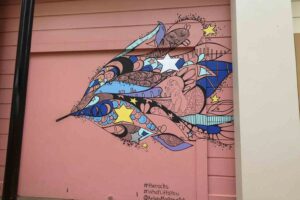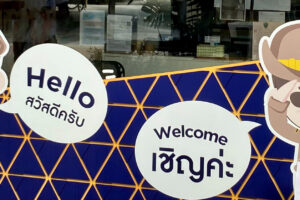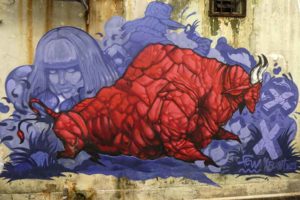I visited Herculaneum on my own, as Dwayne’s old ankle injury was excruciating after walking around Pompeii for hours the day before. I allowed myself two hours to explore Herculaneum, and I think I pretty much saw everything. However, I was rushing a little as I had a set time to meet Dwayne and didn’t want to leave him waiting. These ruins absolutely enthralled me. They are well preserved and give an exciting look into the lives of the Romans 1940 years ago. I left there with an exhilarated feeling of wonderment, and I believe this is one place you should visit if you get the chance.
Herculaneum, located in the shadow of a volcano, is the lesser-known city that was destroyed by the volcanic eruption of Mount Vesuvius in 79 AD. Over 1900 years ago, a pyroclastic flow (hot gas and volcanic matter) hit the town of Herculaneum at about 160km/h. At this time, Herculaneum was mostly evacuated due to the warning they had after the first eruption, which, due to the prevailing wind, covered Pompeii with tephra but left Herculaneum largely unscathed.
Whereas Pompeii was instantly buried under a dense layer of ash and rock, which collapsed many of the roofs, columns, and walls, Herculaneum was consequently covered by successive pyroclastic flows, which miraculously caused little damage. These flows of hot gas and volcanic matter produced temperatures of up to 500 °C, carbonising many objects, leaving such things as wood and food well preserved in the Herculaneum ruins.
Herculaneum may have been the smaller of the cities, but it was nonetheless the wealthier. The exceptional preservation of the town clearly depicts the impressive number of affluent houses and many examples of lavish flooring and frescoes, lending itself to an extraordinary look back in time.
Barrel Arches and the Skeletons
These arched rooms were used as boat sheds and port warehouses. Many skeletons were found in these rooms. Almost 300 skeletons have been excavated from this area, including the beach. It is thought they were waiting, sheltered in the boat sheds, to be rescued.
Scientists who have analysed the bones declared that these unfortunate people died from the extreme heat of the eruption. The temperature of the pyroclastic flows incinerated their flesh within seconds and caused some people’s brains to burst from the pressure and heat. This is evident from the remaining holes within some skulls. Rather gruesome, yes, but also an extraordinary look at how people lived their lives over 1900 years ago. Scientists have been able to determine many matters by studying the skeletons; for example, there was a low frequency of tooth decay and cavities, and because of high levels of strontium found in the skeletons, they can deduce that the diet of those at Herculaneum mainly consisted of seafood and vegetables. How interesting!
Well Preserved Wood
Unlike Pompeii, Herculaneum has many examples of well preserved wooden objects, included, but not limited to, balustrades, doors, shelves and a wooden screw press.
Thermopolium
Thermopolium literally means “a place where (something) hot is sold” [wiki]. You will see a few of these restaurants/pubs at Herculaneum. It was customary to have the midday meal in one of these establishments. The ornate marble counter in which large jars (dolia) are embedded is situated at the front of the shop, near the roadside, and one could sit down in the back rooms to eat. The jars contained the goods to be sold.
Frescoes and Murals
Many of the colourful frescoes and murals have been preserved in exceptional condition. Remember, we are talking about art that is nearly 2000 years old. I believe that the number of frescoes and paintings tells a lot about the occupants of the city and is another indication of its wealth.
Ornate Flooring
Most (maybe all) of the mosaic floors I saw are black and white, and they are constructed with tiny pieces. A few are simple geometric shapes, but most are very intricate and decorative, such as the one depicting Neptune and sea creatures.
And there is so much more…
I have only shown you a small part of this fascinating archaeological site. There are many large houses with a multitude of rooms and two-story Domus homes with balconies. Also, the bathhouses—separate for men and women—are well preserved and provide an exciting insight into the lives of the Romans. Furthermore, there is a small museum nearby that houses jewellery, statues, and other artifacts, including big lumps of melted coins. I highly recommend visiting Herculaneum. It is excellent.
More Information
Currency
Euro – EUR – written here as €
€1 = USD 1.12 / AUD 1.62 / GBP 0.90
Visit Herculaneum
Cost – €13 / adult (AUD 21.00 or USD 14.60) purchased at the site.
Opening Hours – Open daily from 8:30 – 17:00 ( November to March) and at 8:30 – 18:00 (April to October).
Guide Book – you can pick up a small guide book for free (it comes in several different languages).
How long to visit?
Easily 3 – 4 hours! But you can see most of it in two hours if you move quickly.
Things to remember when visiting
Take water with you. There is a cafe, but it is outside the grounds – before you enter or after you exit.
Wear comfortable walking shoes.
No smoking allowed.
No pets allowed.
Be respectful – DO NOT WRITE ON THE WALLS – I know some of you are thinking ‘who would do that?’ Plenty of people have, and it is absolutely shameful!
Accommodation
We typically book our accommodation through booking.com. We like the convenience of booking online, and we are usually able to pay for our accommodation on arrival at the hotel/resort or room. booking.com advertise many different accommodation styles in Naples, so you are sure to find the perfect place.
Piazza-Tralia-Pendolo – Pimonte
La Casetta
Cost – €32.00 (AUD 51.70 or USD 36.00) per night.
Pros – Entire apartment with lounge, kitchen/dining, bathroom, large bedroom, washing machine and dishwasher. Fully functional kitchen with excellent facilities. We even cooked a roast goat leg with all the trimmings! The location is good as it is close to public transport and it is a perfect location if you have a car. Free parking. Local grocery store and pizza restaurant within a minute’s walk. Click to read my full review – La Casetta.
Cons – Nothing.
Our verdict – Exceptional value.
Naples
DaRoDa Guest House Napoli
Cost – €22.50 (AUD 36.27 or USD 25.35) per night.
Pros – Good value, friendly hosts, very, very helpful. We like the patio and seating. The room was good, with our own bathroom, we also had a small table and two chairs in the room to use. There are shelves in the room and a hanging rack. The small kitchenette is very basic but was fine for our needs. We were able to heat a quiche for breakfast in the microwave and enjoy our breakfast on the patio with tea and coffee. Tea, coffee, and biscuits provided. The location was good with public transport nearby.
Cons – I don’t think I could complain about anything for the price we paid. It is basic accommodation for the budget traveller.
Our verdict – Good value and location. Lovely hosts. We would stay again!
Antico Lavinaio
Cost – €56.00 (AUD 90.00 or USD 63.00) per night.
Pros – Large room, clean, ours had a sofa, 2 x wardrobes, 2 x desk, 2 x chair, very plain. The location is ok, close to shops and cafes. The kitchen is clean but basic and could probably cook simple meals.
Cons – We only found one power point in the room. The wifi didn’t work. The kitchen is fundamental; no kettle, coffee, tea or sugar etc. We were on the 4th or 5th floor, and with no lift, it was a tough climb with luggage. I didn’t like the stuffed toys in the room as I am allergic to dust mites and the toys are unnecessary.
Our verdict –Inferior value, NOT worth what we paid. I think you can definitely find better. Staying here was a costly mistake.
iVisa
iVisa makes getting a visa super easy. You can even get passport and visa photos done!
Like this post? Please share or pin using the image below, thank you!


“Feet Do Travel” Blog Link Up is a great way for travel bloggers to share their posts. It is also a fabulous way for travellers to find interesting and informative travel blogs to read. Click on the image on the right to learn more!










16 Comments
Leave your reply.